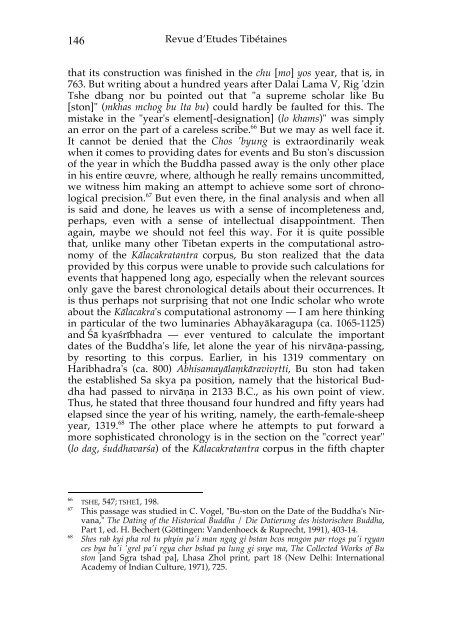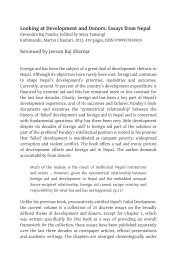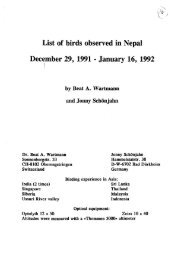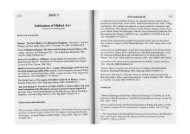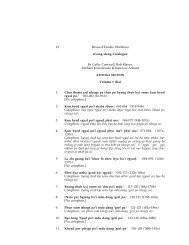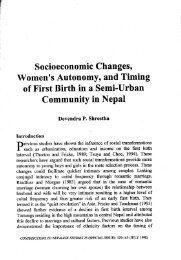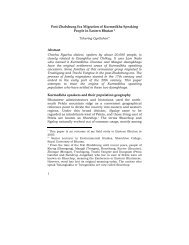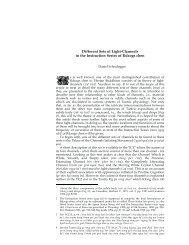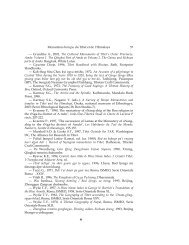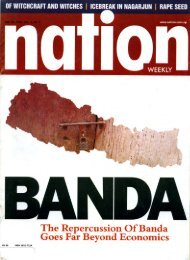Some Remarks on the Textual Transmission and Text of Bu ston
Some Remarks on the Textual Transmission and Text of Bu ston
Some Remarks on the Textual Transmission and Text of Bu ston
Create successful ePaper yourself
Turn your PDF publications into a flip-book with our unique Google optimized e-Paper software.
146<br />
Revue d’Etudes Tibétaines<br />
that its c<strong>on</strong>structi<strong>on</strong> was finished in <strong>the</strong> chu [mo] yos year, that is, in<br />
763. <strong>Bu</strong>t writing about a hundred years after Dalai Lama V, Rig 'dzin<br />
Tshe dbang nor bu pointed out that "a supreme scholar like <strong>Bu</strong><br />
[st<strong>on</strong>]" (mkhas mchog bu lta bu) could hardly be faulted for this. The<br />
mistake in <strong>the</strong> "year's element[-designati<strong>on</strong>] (lo khams)" was simply<br />
an error <strong>on</strong> <strong>the</strong> part <strong>of</strong> a careless scribe. 66 <strong>Bu</strong>t we may as well face it.<br />
It cannot be denied that <strong>the</strong> Chos 'byung is extraordinarily weak<br />
when it comes to providing dates for events <strong>and</strong> <strong>Bu</strong> st<strong>on</strong>'s discussi<strong>on</strong><br />
<strong>of</strong> <strong>the</strong> year in which <strong>the</strong> <strong>Bu</strong>ddha passed away is <strong>the</strong> <strong>on</strong>ly o<strong>the</strong>r place<br />
in his entire œuvre, where, although he really remains uncommitted,<br />
we witness him making an attempt to achieve some sort <strong>of</strong> chr<strong>on</strong>ological<br />
precisi<strong>on</strong>. 67 <strong>Bu</strong>t even <strong>the</strong>re, in <strong>the</strong> final analysis <strong>and</strong> when all<br />
is said <strong>and</strong> d<strong>on</strong>e, he leaves us with a sense <strong>of</strong> incompleteness <strong>and</strong>,<br />
perhaps, even with a sense <strong>of</strong> intellectual disappointment. Then<br />
again, maybe we should not feel this way. For it is quite possible<br />
that, unlike many o<strong>the</strong>r Tibetan experts in <strong>the</strong> computati<strong>on</strong>al astr<strong>on</strong>omy<br />
<strong>of</strong> <strong>the</strong> Kālacakratantra corpus, <strong>Bu</strong> st<strong>on</strong> realized that <strong>the</strong> data<br />
provided by this corpus were unable to provide such calculati<strong>on</strong>s for<br />
events that happened l<strong>on</strong>g ago, especially when <strong>the</strong> relevant sources<br />
<strong>on</strong>ly gave <strong>the</strong> barest chr<strong>on</strong>ological details about <strong>the</strong>ir occurrences. It<br />
is thus perhaps not surprising that not <strong>on</strong>e Indic scholar who wrote<br />
about <strong>the</strong> Kālacakra's computati<strong>on</strong>al astr<strong>on</strong>omy — I am here thinking<br />
in particular <strong>of</strong> <strong>the</strong> two luminaries Abhayākaragupa (ca. 1065-1125)<br />
<strong>and</strong> Śā kyaśrībhadra — ever ventured to calculate <strong>the</strong> important<br />
dates <strong>of</strong> <strong>the</strong> <strong>Bu</strong>ddha's life, let al<strong>on</strong>e <strong>the</strong> year <strong>of</strong> his nirvāṇa-passing,<br />
by resorting to this corpus. Earlier, in his 1319 commentary <strong>on</strong><br />
Haribhadra's (ca. 800) Abhisamayālaṃkāravivṛtti, <strong>Bu</strong> st<strong>on</strong> had taken<br />
<strong>the</strong> established Sa skya pa positi<strong>on</strong>, namely that <strong>the</strong> historical <strong>Bu</strong>ddha<br />
had passed to nirvāṇa in 2133 B.C., as his own point <strong>of</strong> view.<br />
Thus, he stated that three thous<strong>and</strong> four hundred <strong>and</strong> fifty years had<br />
elapsed since <strong>the</strong> year <strong>of</strong> his writing, namely, <strong>the</strong> earth-female-sheep<br />
year, 1319. 68 The o<strong>the</strong>r place where he attempts to put forward a<br />
more sophisticated chr<strong>on</strong>ology is in <strong>the</strong> secti<strong>on</strong> <strong>on</strong> <strong>the</strong> "correct year"<br />
(lo dag, śuddhavarśa) <strong>of</strong> <strong>the</strong> Kālacakratantra corpus in <strong>the</strong> fifth chapter<br />
66<br />
67<br />
68<br />
TSHE, 547; TSHE1, 198.<br />
This passage was studied in C. Vogel, "<strong>Bu</strong>-st<strong>on</strong> <strong>on</strong> <strong>the</strong> Date <strong>of</strong> <strong>the</strong> <strong>Bu</strong>ddha's Nirvana,"<br />
The Dating <strong>of</strong> <strong>the</strong> Historical <strong>Bu</strong>ddha / Die Datierung des historischen <strong>Bu</strong>ddha,<br />
Part 1, ed. H. Bechert (Göttingen: V<strong>and</strong>enhoeck & Ruprecht, 1991), 403-14.<br />
Shes rab kyi pha rol tu phyin pa'i man ngag gi bstan bcos mng<strong>on</strong> par rtogs pa'i rgyan<br />
ces bya ba'i 'grel pa'i rgya cher bshad pa lung gi snye ma, The Collected Works <strong>of</strong> <strong>Bu</strong><br />
st<strong>on</strong> [<strong>and</strong> Sgra tshad pa], Lhasa Zhol print, part 18 (New Delhi: Internati<strong>on</strong>al<br />
Academy <strong>of</strong> Indian Culture, 1971), 725.


